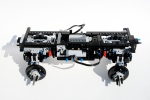Kenworth T55
April 28, 2012 8 Comments
Traction. It’s all about traction when designing a trial truck. Because of this, many builders have tried a number of different solutions in designing their own trucks: differentials, gearboxes, various numbers of wheels, various gears ratios, countless suspension designs, and on and on. So why would it be any different for my trucks? Every truck I make is a reaction to some set of problems I have encountered with a previous truck. This is my current solution.
The full gallery is here. Instructions are here.
The Kenworth T55 started as a proof of concept, and turned into a design of a fictional truck. I wanted to somehow see if there was a way to use differentials in a successful trial truck. For this to work, two things had to be accomplished. First, there had to be a way to keep the tires from spinning uncontrollably when they lost contact with the ground. And second, the torque going through the differential had to be low enough that it would not shred the gears inside the differential when the truck encountered an obstacle. Could I make axles that had a limited slip differential while having all of the gear reduction at the hub?
Enter turntables. I have seen some ideas before, most sigificantly from Borec, including this truck, so I went to work. I designed a mount for the wheels and tires, and placed the universal joint as close the wheels as I could. Then I used a limited slip differentail design, and sent the driveshaft back to the body. A simple steering design was used, and the two fuctions passed through the common design of using a differental body through a turntable.
The chassis was designed to keep the weight low, both is mass and location. As is common, I used the Power Functions XL motor for drive, and I decided to use the 8878 Battery box as it was significally lighter than the other design. In addition, I would have a drive shaft and a steering shaft running the length of the truck, so the motor and power pack needed to set on both sided of the truck. Also, because I used the turntables, the drive shaft was very high. This gave great ground clearance, but I needed to keep the heavy components low. By having both large components on the side, I was able to keep a short wheelbase of 30 studs, and keep the mass centered and low. The driveline was complete.
Ever since my GMC 2500, I have held to the belief that a linked suspension is the most efective setup for four wheel trial trucks. The design keeps all four wheels firmly planned, and does not have the wobbling feel of many pendular suspension designs. But as is often the case, I ran out of room to place a link rod between the two wheels so I opted with useing the rubber connectors to keep the axles level. I added a body, and a steering motor, wired everything together, and I was done.
So how did it work. As you can see in the video, the suspension was effected by the steering and drive shafts. This further confirms my thoughts on the linked suspension. Second, the turntables did not really add much. They added a lot of friction to the driveline, and though they kept the differentials safe because of the tall final gear they did not really isolate the forces on the differential as much as I would have liked. Third, the limited slip differentials worked well, but still allowed for too much wheel slip. I ended up replacing the rear with a locked axle, which seemed to work well. So, for the next truck, bring back the linked suspension, and find a better differential solution. Maybe then I can find some more traction.












Who knew……
This blog has a lot of very useful information on it! Cheers for helping me!
Anytime. I am glad my MOCs help your creativity.
Hello, my son really liked your model. He constantly monitors your blog. Could you make the instructions for this model, as you did in 8081, and the list details that you used for its construction. I would be very appreciated you. Thanks.
Thanks Andriy. Most of the model has been taken apart, but I may be able to post some additional helpful photos on the brickshelf.com gallery. Send me an email for specific questions.
Pingback: Mack Marble 5T « Thirdwigg.com
Pingback: 2013 | Thirdwigg.com
Pingback: Kenworth T47 | Thirdwigg.com